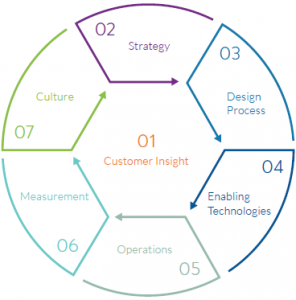The second of the seven customer experience (CX) dimensions discussed in Perficient Digital’s CX guide is Strategy. You can see in the diagram below that it sits right on top of the first (and most critical) dimension: Customer Insight.
CX Strategy Purpose and Scope
Within the context of CX, strategy encompasses the description of the experience that you intend to deliver and the associated value that you offer your customers. Your CX strategy provides direction that helps you prioritize initiatives/projects/activities in support of your enterprise goals.
Because “customer” means many different things in life sciences (e.g., patient, physician, clinical site, clinical subject, research partner, regulatory agency, vendor, employee), you will likely need a different CX strategy for each customer group. Each strategy will be based on the customer insights you gather about that group, and will describe the way you want that group to experience you and the value you will provide them with through that experience.
Characteristics of an Effective CX Strategy
To be most effective, your CX strategy must be driven by customer needs, be supported by the employees who deliver it every day, and deliver on your brand promise and value proposition – yes, even your brand promise and value proposition to employees, research partners, and regulatory agencies.
An effective CX strategy includes:
- A clearly articulated vision with supporting strategies
- Competitive insight that enables you to differentiate your CX
- Organizational alignment to support a consistent experience across all touchpoints
- Success metrics that connect business performance with CX excellence
- A road map to guide the implementation of approved projects
- A capital budget that provides sufficient resources to execute the plan
Best Practice: Create a CX Road Map…and Defend It
A thoughtful CX strategy establishes the vision for your company, but the benefits aren’t realized until the strategy is executed. This is why the strategy needs to include a road map to guide the executional effort.
It takes a tremendous amount of work to develop an effective CX road map. Once in place, it is essential that all future projects demonstrate how they will advance the company’s CX effectiveness and are vetted and prioritized accordingly. It is equally important to remember that diluting funding and resources in an attempt “to do more” typically undermines your organization’s probability of success.
In the next post, I’ll discuss the third dimension of CX: Design Process.


